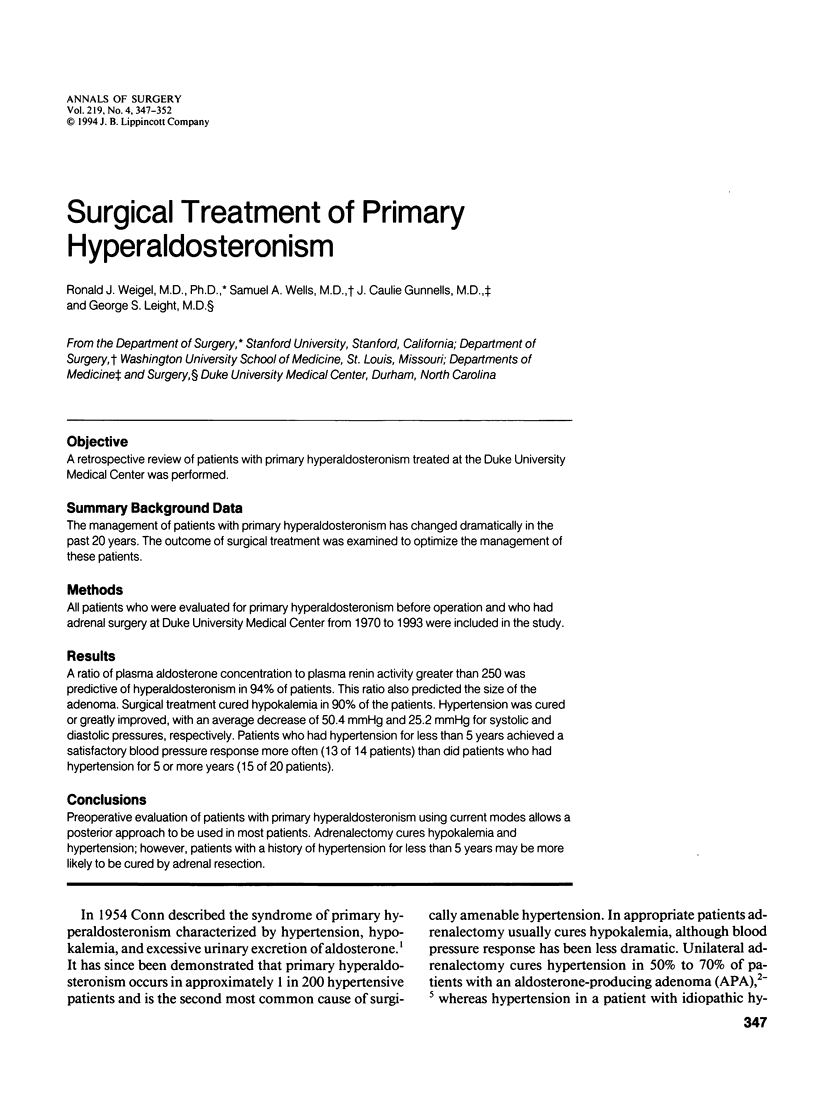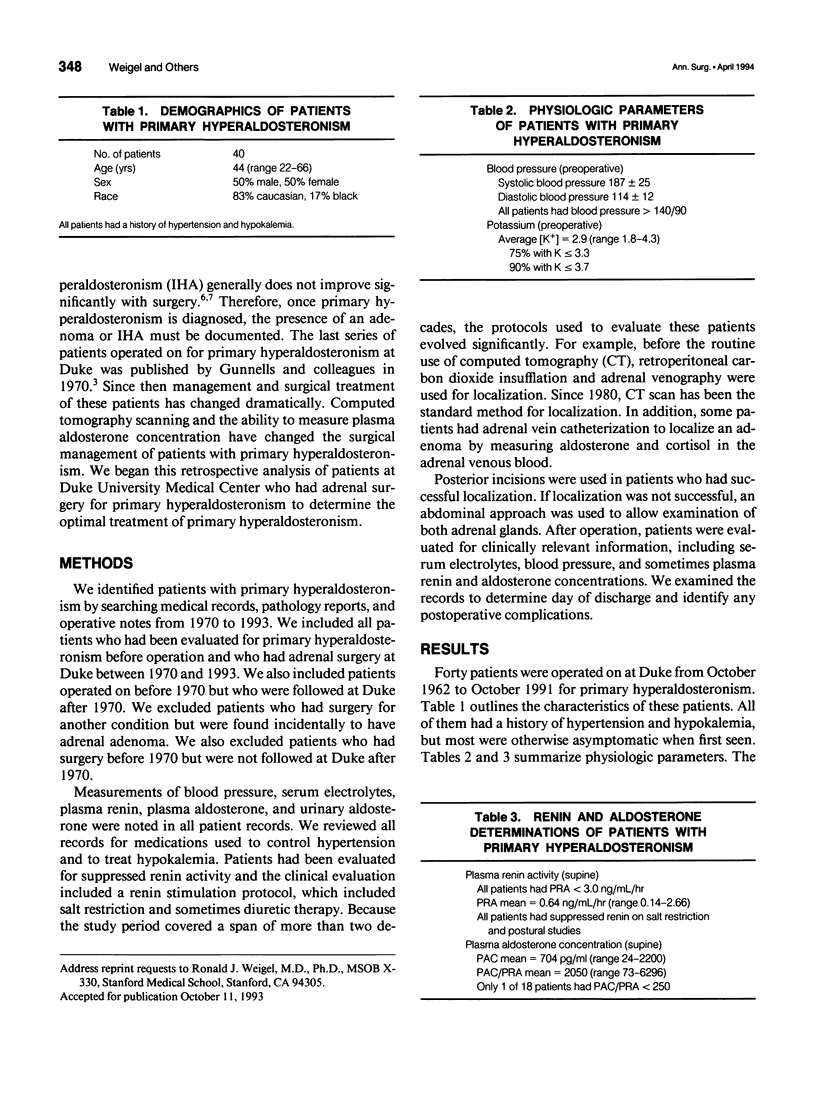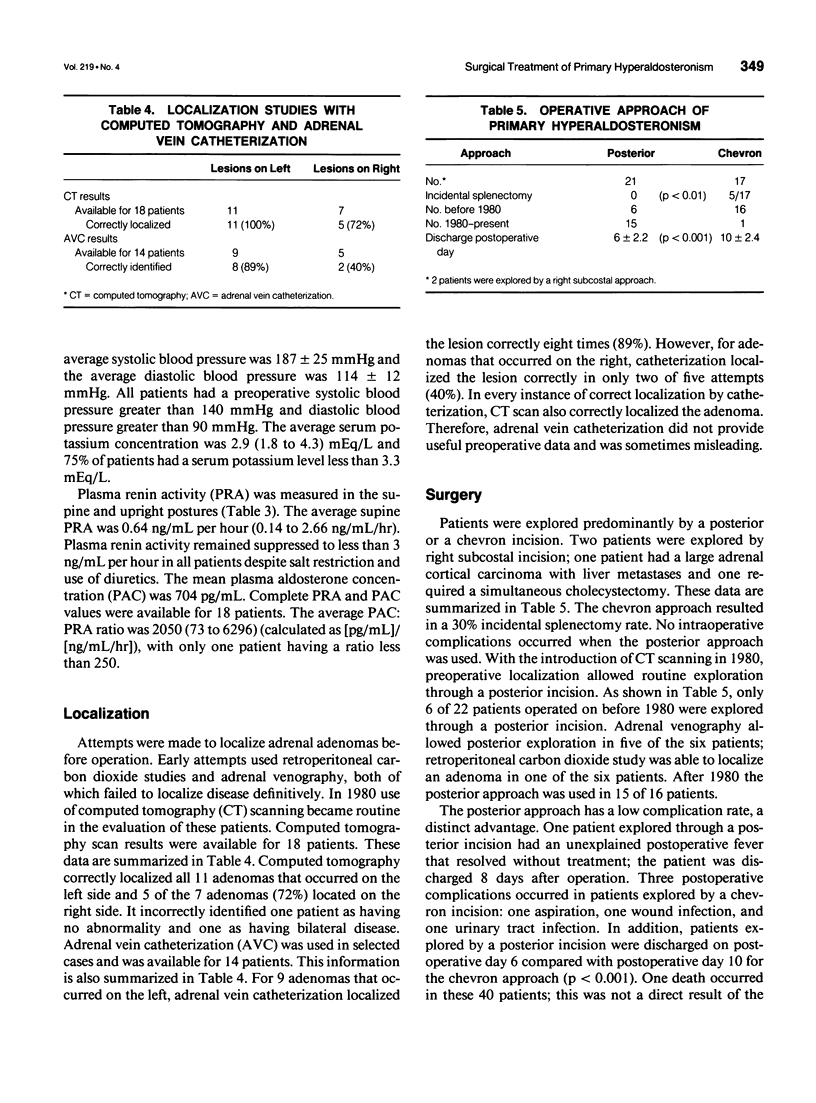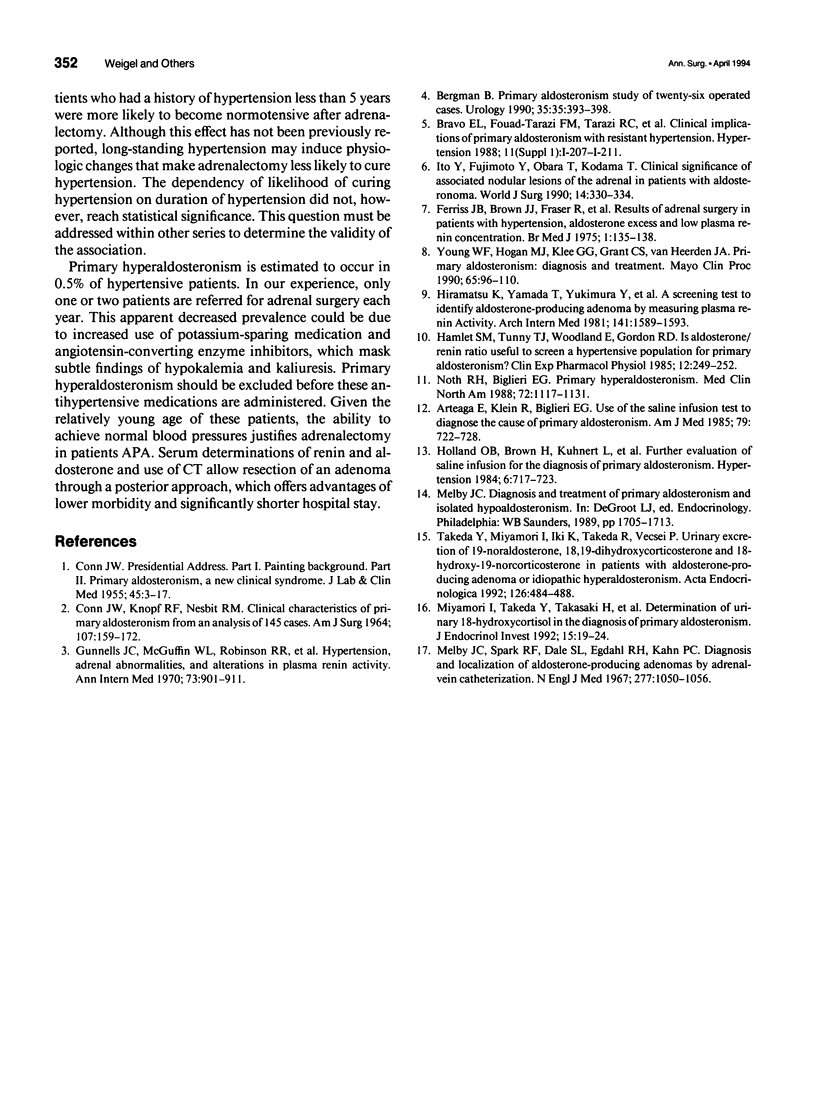Abstract
OBJECTIVE: A retrospective review of patients with primary hyperaldosteronism treated at the Duke University Medical Center was performed. SUMMARY BACKGROUND DATA: The management of patients with primary hyperaldosteronism has changed dramatically in the past 20 years. The outcome of surgical treatment was examined to optimize the management of these patients. METHODS: All patients who were evaluated for primary hyperaldosteronism before operation and who had adrenal surgery at Duke University Medical Center from 1970 to 1993 were included in the study. RESULTS: A ratio of plasma aldosterone concentration to plasma renin activity greater than 250 was predictive of hyperaldosteronism in 94% of patients. This ratio also predicted the size of the adenoma. Surgical treatment cured hypokalemia in 90% of the patients. Hypertension was cured or greatly improved, with an average decrease of 50.4 mmHg and 25.2 mmHg for systolic and diastolic pressures, respectively. Patients who had hypertension for less than 5 years achieved a satisfactory blood pressure response more often (13 of 14 patients) than did patients who had hypertension for 5 or more years (15 of 20 patients). CONCLUSIONS: Preoperative evaluation of patients with primary hyperaldosteronism using current modes allows a posterior approach to be used in most patients. Adrenalectomy cures hypokalemia and hypertension; however, patients with a history of hypertension for less than 5 years may be more likely to be cured by adrenal resection.
Full text
PDF





Selected References
These references are in PubMed. This may not be the complete list of references from this article.
- Arteaga E., Klein R., Biglieri E. G. Use of the saline infusion test to diagnose the cause of primary aldosteronism. Am J Med. 1985 Dec;79(6):722–728. doi: 10.1016/0002-9343(85)90523-6. [DOI] [PubMed] [Google Scholar]
- Bergman B. Primary aldosteronism. Study of twenty-six operated cases. Urology. 1990 May;35(5):393–398. doi: 10.1016/0090-4295(90)80079-3. [DOI] [PubMed] [Google Scholar]
- CONN J. W., KNOPF R. F., NESBIT R. M. CLINICAL CHARACTERISTICS OF PRIMARY ALDOSTERONISM FROM AN ANALYSIS OF 145 CASES. Am J Surg. 1964 Jan;107:159–172. doi: 10.1016/0002-9610(64)90252-1. [DOI] [PubMed] [Google Scholar]
- CONN J. W. Presidential address. I. Painting background. II. Primary aldosteronism, a new clinical syndrome. J Lab Clin Med. 1955 Jan;45(1):3–17. [PubMed] [Google Scholar]
- Ferriss J. B., Brown J. J., Fraser R., Haywood E., Davies D. L., Kay A. W., Lever A. F., Robertson J. I., Owen K., Peart W. S. Results of adrenal surgery in patients with hypertension, aldosterone excess, and low plasma renin concentration. Br Med J. 1975 Jan 18;1(5950):135–138. doi: 10.1136/bmj.1.5950.135. [DOI] [PMC free article] [PubMed] [Google Scholar]
- Gunnells J. C., Jr, McGuffin W. L., Jr, Robinson R. R., Grim C. E., Wells S., Silver D., Glenn J. F. Hypertension, adrenal abnormalities, and alterations in plasma renin activity. Ann Intern Med. 1970 Dec;73(6):901–911. doi: 10.7326/0003-4819-73-6-901. [DOI] [PubMed] [Google Scholar]
- Hamlet S. M., Tunny T. J., Woodland E., Gordon R. D. Is aldosterone/renin ratio useful to screen a hypertensive population for primary aldosteronism? Clin Exp Pharmacol Physiol. 1985 May-Jun;12(3):249–252. doi: 10.1111/j.1440-1681.1985.tb02641.x. [DOI] [PubMed] [Google Scholar]
- Hiramatsu K., Yamada T., Yukimura Y., Komiya I., Ichikawa K., Ishihara M., Nagata H., Izumiyama T. A screening test to identify aldosterone-producing adenoma by measuring plasma renin activity. Results in hypertensive patients. Arch Intern Med. 1981 Nov;141(12):1589–1593. [PubMed] [Google Scholar]
- Holland O. B., Brown H., Kuhnert L., Fairchild C., Risk M., Gomez-Sanchez C. E. Further evaluation of saline infusion for the diagnosis of primary aldosteronism. Hypertension. 1984 Sep-Oct;6(5):717–723. doi: 10.1161/01.hyp.6.5.717. [DOI] [PubMed] [Google Scholar]
- Ito Y., Fujimoto Y., Obara T., Kodama T. Clinical significance of associated nodular lesions of the adrenal in patients with aldosteronoma. World J Surg. 1990 May-Jun;14(3):330–334. doi: 10.1007/BF01658518. [DOI] [PubMed] [Google Scholar]
- Melby J. C., Spark R. F., Dale S. L., Egdahl R. H., Kahn P. C. Diagnosis and localization of aldosterone-producing adenomas by adrenal-vein cateterization. N Engl J Med. 1967 Nov 16;277(20):1050–1056. doi: 10.1056/NEJM196711162772002. [DOI] [PubMed] [Google Scholar]
- Miyamori I., Takeda Y., Takasaki H., Itoh Y., Iki K., Takeda R. Determination of urinary 18-hydroxycortisol in the diagnosis of primary aldosteronism. J Endocrinol Invest. 1992 Jan;15(1):19–24. doi: 10.1007/BF03348648. [DOI] [PubMed] [Google Scholar]
- Noth R. H., Biglieri E. G. Primary hyperaldosteronism. Med Clin North Am. 1988 Sep;72(5):1117–1131. doi: 10.1016/s0025-7125(16)30732-5. [DOI] [PubMed] [Google Scholar]
- Takeda Y., Miyamori I., Iki K., Takeda R., Vecsei P. Urinary excretion of 19-noraldosterone, 18, 19-dihydroxycorticosterone and 18-hydroxy-19-norcorticosterone in patients with aldosterone-producing adenoma or idiopathic hyperaldosteronism. Acta Endocrinol (Copenh) 1992 Jun;126(6):484–488. doi: 10.1530/acta.0.1260484. [DOI] [PubMed] [Google Scholar]
- Young W. F., Jr, Hogan M. J., Klee G. G., Grant C. S., van Heerden J. A. Primary aldosteronism: diagnosis and treatment. Mayo Clin Proc. 1990 Jan;65(1):96–110. doi: 10.1016/s0025-6196(12)62114-4. [DOI] [PubMed] [Google Scholar]


